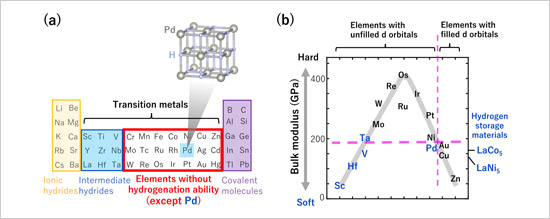Lattice Softness: Key to the Identification of Metals with High Hydrogenation Abilities
2021.08.30
National Institute for Materials Science (NIMS)
Tokyo Institute of Technology
The development of metallic hydrides with large hydrogen storage capacities will be crucial in bringing a hydrogen economy into existence. NIMS and the Tokyo Institute of Technology have discovered that the hardness of base metals—an ingredient for hydride synthesis—is the dominant factor affecting their ability to hydrogenate.
Abstract
- The development of metallic hydrides with large hydrogen storage capacities will be crucial in bringing a hydrogen economy into existence. NIMS and the Tokyo Institute of Technology have discovered that the hardness of base metals—an ingredient for hydride synthesis—is the dominant factor affecting their ability to hydrogenate. This simple parameter may be used to expedite the development of hydrogen storage materials by streamlining conventional trial-and-error material exploration processes.
- Metallic hydrides capable of storing large amounts of hydrogen are expected to play a key role in achieving the widespread use of hydrogen. Although palladium (Pd) has already been in practical use as a hydrogen permeable material, this precious metal is expensive. While Pd has a high hydrogenation capacity, other transitional metal elements in the vicinity of Pd on the periodic table are known to exhibit very poor hydrogenation. Understanding the unique hydrogenation properties of Pd may help in the development of more economical metallic materials with desirable hydrogen-related functionalities.
- During hydrogenation reactions, the outermost d orbital of a transition metal bonds with hydrogen atoms, resulting in the formation of a solid hydride. This research team focused on chemical bonding between transition metals and hydrogen atoms and identified a unique characteristic of Pd hydrides: they have soft lattice structures. The team then compared the hydrogenation abilities of Pd and other transition metals in the vicinity of Pd on the periodic table. This was done by estimating their bulk moduli (a measure of substances’ resistance to compression, indicating their hardness) through electronic structure calculations. As a result, the team found that transition metals with lattices as soft as Pd’s (metals with bulk modulus values below the threshold indicated by the pink horizontal line in figure (b)) tended to hydrogenate easily. Elements located on the left and right sides of the transition metal section of the periodic table generally have soft lattices. However, not all soft metals have high hydrogenation abilities: some transition metals with soft lattices (i.e., copper and zinc group elements) are incapable of hydrogenation because their d orbitals are completely filled with electrons, preventing them from bonding with hydrogen. The team also demonstrated that this lattice softness parameter can be used to evaluate the hydrogenation ability not only of metals and alloys but also of intermetallic hydrogen storage compounds. This parameter is uniquely correlated with hydride synthesis; it has no reported correlation with the synthesis of inorganic compounds, such as oxides and nitrides.
- These findings may be used to expedite evaluation of the hydrogen storage capacities of newly developed alloys and intermetallic compounds. In future research, this team hopes to develop intermetallic compounds with desirable hydrogen-related functionalities (e.g., hydrogen permeable and storage materials) using inexpensive chemical elements with stable supplies. The team also envisages exploring the use of these new materials in a wider range of chemical applications.
- This project was carried out by a research team consisting of Hideo Hosono (Distinguished Fellow, ElectroActive Materials Team (EAMT), International Center for Materials Nanoarchitectonics (MANA), NIMS; also Honorary Professor, Tokyo Institute of Technology), Hiroshi Mizoguchi (Special Researcher, EAMT, MANA, NIMS) and Sang-Won Park (Visiting Researcher, EAMT, MANA, NIMS). This work was supported by the World Premier International Research Center Initiative (WPI) and the MEXT Element Strategy Initiative to form core research centers.
- This research was published in the online version of the Journal of the American Chemical Society as an “ASAP article” on July 21, 2021.

Figure. (a) Grouping of chemical element on the periodic table that form different types of hydrides. (b) Bulk moduli and hydrogen absorption capacities of various transition metals and representative intermetallic compounds. Materials evaluated may be divided into those with hydrogen storage capability (blue) and those without (black).
Related files
- International Center for Materials Nanoarchitectonics (MANA)
Contact information
(Regarding this research)
-
Hideo Hosono
Distinguished Fellow/Team Leader
ElectroActive Materials Team
International Center for Materials Nanoarchitectonics
National Institute for Materials Science
Tel: +81-45-924-5009
E-Mail: HOSONO.Hideo=nims.go.jp
(Please change "=" to "@")
E-Mail: hosono=mces.titech.ac.jp
(Please change "=" to "@") -
Hiroshi Mizoguchi
NIMS Special Researcher
ElectroActive Materials Team
International Center for Materials Nanoarchitectonics
National Institute for Materials Science
Tel: +81-29-851-3354
E-Mail: MIZOGUCHI.Hiroshi=nims.go.jp
(Please change "=" to "@")
(General information)
-
Public Relations Office
National Institute for Materials Science
Tel: +81-29-859-2026
Fax: +81-29-859-2017
E-Mail: pressrelease=ml.nims.go.jp
(Please change "=" to "@") -
Public Relations Division
General Affairs Department
Tokyo Institute of Technology
Tel: +81-3-5734-2975
Fax: +81-3-5734-3661
E-Mail: media=jim.titech.ac.jp
(Please change "=" to "@")
(Regarding the MEXT Element Strategy Initiative to form core electronic material research centers)
-
Hideo Hosono
National Institute for Materials Science (NIMS)
Same Keywords
-
Evolving Hydrogen-storage Technology: Guidelines Developed for the Design of Anti-evaporation Catalysts
(hydrogen,Tokyo Institute of Technology)
2023.12.15
-
Discovery of Non-Toxic Semiconductors with a Direct Band Gap in the Near-Infrared
(Tokyo Institute of Technology)
2020.12.11
-
Development of a New Technique for Growing High-Quality GaN Crystals
(Tokyo Institute of Technology)
2020.11.12
